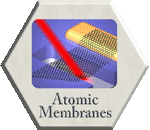Home⁄ Atomic Membranes
Atomic Membranes
 IRG Senior Participants:
IRG Senior Participants:
Jiwoong Park (Chem, co-leader), Paul McEuen (Phys, co-leader), Itai Cohen (Phys), Harold Craighead (ApplPhys), Erik Demaine (Math & CompSci, MIT), Will Dichtel (Chem), Julius Lucks (BiomolE), David Muller (ApplPhys), Jeevak Parpia (Phys), Farhan Rana (ElecE), Mike Spencer (ElecE), Mukund Vengalattore (Phys)
Collaborators: Cecilia Noguez (Nat’l Autonomous Univ. of Mexico), Abhay Pasupathy, James Hone (Columbia Univ.), Kyle Shen (Cornell Univ.), Francesco Massel (Univ. of Helsinki, Finland), Rudra Pratap (IISc, Bangalore, India)
Atomic membranes are a new class of two-dimensional, free-standing materials only one atom thick yet mechanically robust, chemically stable, and virtually impermeable. The prototype atomic membrane is graphene, a honeycomb lattice entirely made of carbon atoms, but other emerging systems such as the III-V boron nitride (BN) materials offer exciting new properties. Since our team reported (along with the Geim group) the first suspended atomic membranes in 2007, progress in the field has been stunning. Applications loom in almost every technological sector from electronics to chemical passivation. In particular, atomic membranes will lead to novel mechanical and window devices at a large, technologically-relevant scale, highly tunable and ultra-sensitive nano-electromechanical devices for controlling and sensing nanometer scale objects, and outstanding window materials for novel x-ray and TEM studies. Our group is working to address the major materials challenges facing the realization of these applications.
E-mail IRG leaders: Paul McEuen and Jiwoong Park
